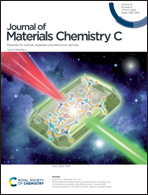FeV3O8/MoS2 nanostructure heterojunctions as a highly effective electrocatalyst for hydrogen evolution†
Abstract
Great efforts have been made to explore efficient, stable and resource-rich non-noble metal electrocatalysts instead of noble metal electrocatalysts for the hydrogen evolution reaction (HER). As typical 2D transition-metal dichalcogenide (TMD) electrocatalysts, the application of MoS2 in water splitting is restricted due to its poor conductivity and having lots of inactive sites at the edge. The preparation of a MoS2 composite heterojunction was deemed to be a promising way to enhance the electrocatalytic performance. Herein, FeV3O8/MoS2 (FVO/MS) heterostructures were in situ constructed by synthesizing graphene-like MoS2 nanosheets on FeV3O8 nanorods. The phase structure, morphology and chemical composition of the samples were analyzed by XRD, FESEM, XPS, HRTEM and Raman spectra, respectively; these results confirmed that FVO/MS were successfully coupled together and formed a clear and intimate interface. According to the electrochemical tests under acid conditions (0.5 M H2SO4), the FVO40-MS heterostructure presents an impressive HER catalytic ability with a lower overpotential of 160 mV (at 10 mA cm−2) and a smaller Tafel slope of 53 mV dec−1 in contrast to pure MoS2. Combining all the test results, the improved HER performance of FVO/MS catalysts was found to be derived from the synergistic effect between FeV3O8 and MoS2, the increased active sites at the edge of the heterojunction, the enhanced conductivity and the larger BET surface area. This work may provide a valuable way of developing MoS2-based electrocatalysts for the HER in acid systems.



 Please wait while we load your content...
Please wait while we load your content...